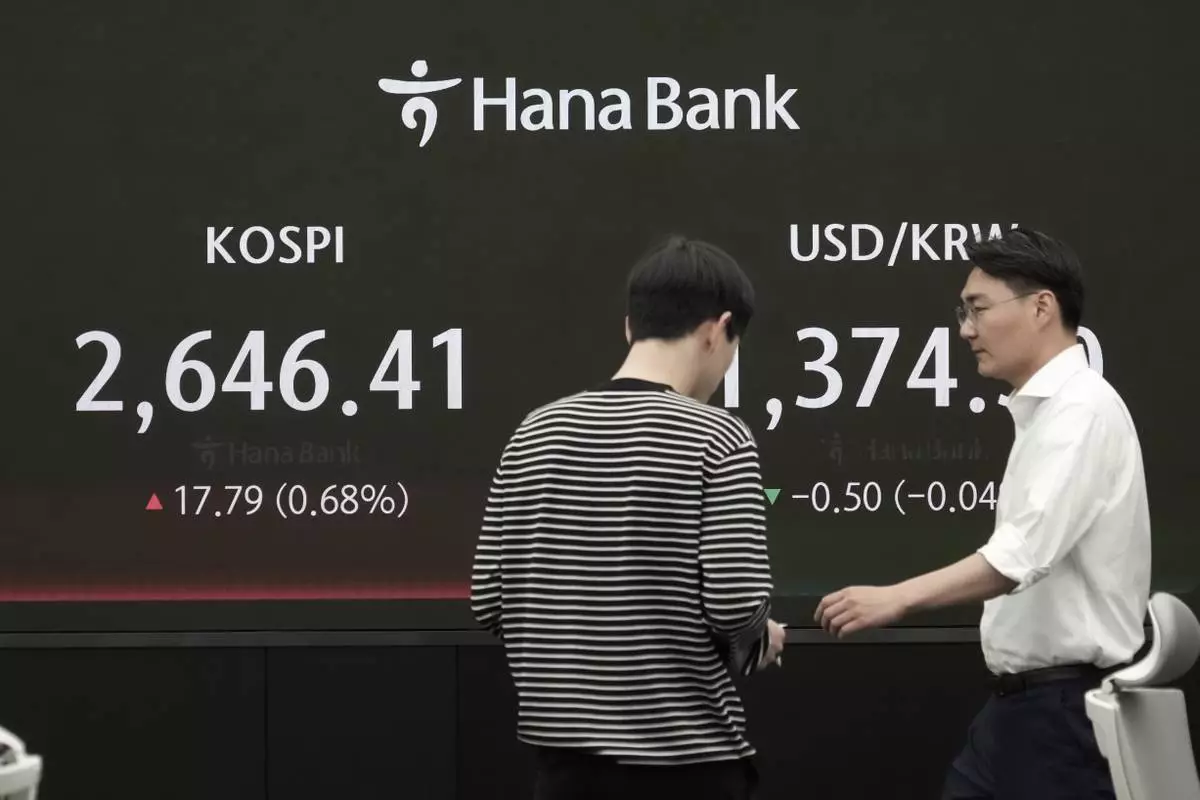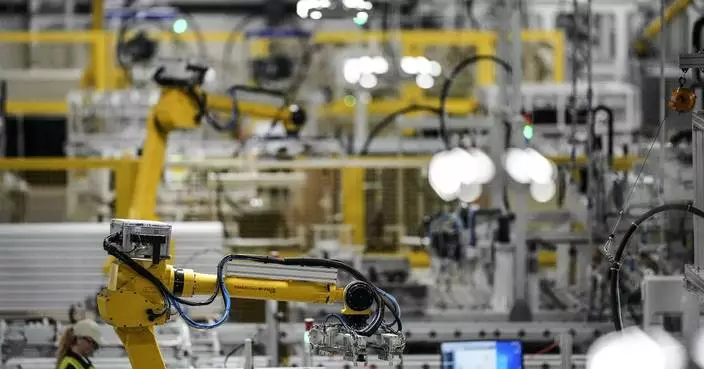It was dragons vs. zombies in fiery combat during this week's "Game of Thrones," a battle that likely provides just a hint of what lies ahead in HBO's hit series.
Yet the epic scene also raised an economic question: Can the White Walkers' command-and-control economy defeat their disorganized, squabbling Westerosi opponents?
The Associated Press' economics team explores this question, as well as the growing rivalry between sisters Sansa and Arya Stark, in the latest episode of our audio series, "The Wealth of Westeros." We were joined by Carolyne Larrington , a professor of medieval English literature at Oxford.

This photo provided by HBO shows a scene from the sixth episode of the seventh season of HBO's "Game of Thrones." Dragons fought zombies in a thunderous battle on “Game of Thrones” on Sunday, Aug. 20, 2017, a showdown that provides just a hint of what likely lies ahead in the show’s final season. Yet the battle also raised an economic question: Can the White Walkers' command and control economy defeat their disorganized, squabbling Westerosi opponents? (Courtesy of HBO via AP)
The icy, humanoid White Walkers have mobilized a fearsome, unthinking army of zombies against the population of Westeros, the Europe-like continent where the show mostly takes place. Their top-down, centralized approach can be intimidating from a military perspective. It can also help an economy accelerate temporarily, as the Soviet Union's did after World War II.
But this week's episode provides clues about the shortcomings of this approach. When a White Walker is killed by Jon Snow, all the zombies created by that White Walker also die off.
In other words, in a system with no individual autonomy or decision-making, the White Walker army is useless without its leaders.
By contrast, Jon Snow, Daenerys Targaryen and their compatriots bicker incessantly about strategy, but their less-centralized approach allows individuals like Snow to take risks and make their own decisions. Historically, economies that allow entrepreneurs to do the same have provided greater prosperity than those run from the top down.
Some other highlights from this week's show:
— SISTERLY RIVALRY GETS OUT OF HAND
One surprise this season has been the growing suspicion and ill-will between Sansa and Arya Stark. Both have suffered terribly after their mother and oldest brother were killed at the infamous "Red Wedding," and the scars they bear seem to be pushing them further apart.
This week, Arya attacks Sansa for a letter she wrote — against her will — years earlier, urging her older brother, Robb, to pledge his loyalty to the spoiled, evil King Joffrey.
Larrington, who wrote a book titled "Brothers and Sisters in Medieval European Literature," as well as "Winter Is Coming: the Medieval World of Game of Thrones," said the conflict is unusual for its time, because it doesn't involves a romantic rivalry.
"When sisters fall out in traditional stories like this, it's usually over a man," she said. "They both want the same man," but that's not true in this case.
"It's not like they both want Littlefinger, I mean God forbid," Larrington added. "They're not going to predestined paths like most medieval women would have done, which is getting married at quite a young age. They are actually fighting for power, fighting for self-determination, and it has cost both of them quite a lot."
WINTER IS COMING — AND SO IS CLIMATE CHANGE?
The show's catchphrase, "Winter Is Coming," refers to both the harsh, extended winters that can last for years in Westeros as well as the White Walker invasion. It's long been seen as a metaphor for climate change.
Just like climate change, the threat is two-fold: The people of Westeros have to figure out how to defeat the White Walkers, and also how to convince many of their compatriots that the threat is real.
In "Game of Thrones," the White Walkers haven't appeared for thousands of years, so it's not surprising that many characters on the show regard them as myths.
But even with all our advances in science and communications, it's still difficult to achieve consensus in the United States — and globally — on whether global warming constitutes a serious threat.
DRAGON V. DRAGON
The White Walkers now have their own zombie dragon, after killing one of Daenerys's dragons and capturing its corpse. This raises an interesting question of military strategy that has been studied by economists who specialize in game theory: Now that both sides have weapons of mass destruction, will they hold back from using them, as modern nuclear powers have done? Or will it increase the incentives for one side to strike first?
This is "Game of Thrones" we're talking about, so the safe answer is the latter one.
NEW YORK (AP) — The best week for U.S. stocks since November closed out with more gains thanks to Alphabet and Microsoft on Friday.
The S&P 500 rallied 1% to finish its first winning week in the last four. The Dow Jones Industrial Average rose 153 points, or 0.4%, and the Nasdaq composite jumped 2%.
Alphabet leaped 10.2% after breezing past analysts’ expectations for profit last quarter. The parent company of Google also said it will start paying a dividend to investors and authorized a program to buy back up to $70 billion of its stock, a signal of how much cash it's generating.
Microsoft, meanwhile, climbed 1.8% after reporting stronger profit and revenue than expected. It cited strong growth in its cloud-computing business as it pushes artificial-intelligence technology to its customers.
They helped offset a 9.2% drop for Intel. It reported stronger profit for the latest quarter than expected, but its revenue fell short of analysts’ estimates. So did its forecast for profit in the current quarter.
Stocks have broadly been under pressure this month after hopes withered for multiple cuts to interest rates this year by the Federal Reserve. A series of reports this year showing inflation remaining worse than forecast has traders expecting maybe one cut this year, down from forecasts for six or more at the start of the year.
Yet another report on Friday showed inflation remaining stubbornly high. This time it was the measure of prices for March that the Federal Reserve prefers to use, but it wasn’t much worse than forecasts. Financial markets took it much more in stride than a report from the day before that suggested the same measure of inflation rose quickly from January through March.
Treasury yields largely eased in the bond market following Friday morning's report. The yield on the 10-year Treasury fell to 4.66% from 4.71% late Thursday. The two-year Treasury yield, which more closely tracks expectations for the Fed, held steadier. It edged down to 4.99% from 5.00%.
While inflation has remained hotter than forecast, EY Chief Economist Gregory Daco expects it to cool in coming months as shoppers pressured in part by slowing growth in wages tamp down their purchases, which is the fuel that gives inflation energy.
“Consumers remain willing to spend, but not on anything, nor at any price,” he said.
Economists also said the weaker-than-expected reading on the overall U.S. economy from Thursday, which helped send stocks sliding, may not be as bad as it seemed on the surface.
“The economy remains on solid footing,” Bank of America economists said in a report, pointing to solid buying trends from U.S. customers. Such an interpretation calms worries that the U.S. economy could be heading for a toxic mix of stagnating growth and high inflation, something that the Federal Reserve doesn’t have great tools to fix.
Still, the higher-than-expected inflation readings will likely keep the Fed on hold at its next policy meeting on Wednesday. Its main interest rate has been sitting at the highest level since 2001 in hopes of undercutting inflation by putting downward pressure on the economy and financial markets.
After earlier indicating that three cuts to interest rates could be on the way this year, top Fed officials have since said they could hold its main interest rate high for a while to ensure inflation heads down toward their 2% target.
Friday's report on sticky inflation “underscores Vanguard’s belief that the Federal Reserve may find it’s unable to cut interest rates this year,” according to the investment giant's global head of portfolio construction, Roger Aliaga-Diaz.
If interest rates stay high, companies will need to produce stronger profits for their stock prices to rise. So far this reporting season, the trend has been better than expected.
Roughly three out of four companies have been topping analysts' forecasts for profit, according to FactSet. That includes ResMed, which reported healthier profit and revenue than expected late Thursday. Its stock jumped 18.9% for Friday's biggest gain in the S&P 500.
All told, the S&P 500 rose 51.54 points to 5,099.96. The Dow added 153.86 to 38,239.66, and the Nasdaq gained 316.14 to 15,927.90.
In stock markets abroad, Japan's Nikkei 225 rose 0.8% after the Bank of Japan ended a policy meeting with no major changes to interest rates. Indexes also rose across much of the rest of Asia and Europe.
AP Business Writer Yuri Kageyama contributed.

A trader works on the floor of the New York Stock Exchange shortly after the opening bell, Wednesday, April 24, 2024, in New York. (AP Photo/Mary Altaffer)

Traders work on the floor of the New York Stock Exchange shortly after the opening bell, Wednesday, April 24, 2024, in New York. (AP Photo/Mary Altaffer)

Currency traders pass by the screen showing the Korea Composite Stock Price Index (KOSPI), left, and the foreign exchange rate between U.S. dollar and South Korean won at the foreign exchange dealing room of the KEB Hana Bank headquarters in Seoul, South Korea, Friday, April 26, 2024. Asian shares mostly rose Friday despite worries about the economic outlook and inflation in the U.S. and the rest of the world. (AP Photo/Ahn Young-joon)

Currency traders watch monitors near the screen showing the Korea Composite Stock Price Index (KOSPI) at the foreign exchange dealing room of the KEB Hana Bank headquarters in Seoul, South Korea, Friday, April 26, 2024. Asian shares mostly rose Friday despite worries about the economic outlook and inflation in the U.S. and the rest of the world. (AP Photo/Ahn Young-joon)

A currency trader passes by the screen showing the Korea Composite Stock Price Index (KOSPI), left, at the foreign exchange dealing room of the KEB Hana Bank headquarters in Seoul, South Korea, Friday, April 26, 2024. Asian shares mostly rose Friday despite worries about the economic outlook and inflation in the U.S. and the rest of the world. (AP Photo/Ahn Young-joon)















